
Lyme Park is a large estate located south of Disley, Cheshire. The estate is managed by the National Trust and consists of a mansion house surrounded by formal gardens, in a deer park in the Peak District National Park. The house is the largest in Cheshire, and is recorded in the National Heritage List for England as a designated Grade I listed building.

Clevedon Court is a manor house on Court Hill in Clevedon, North Somerset, England, dating from the early 14th century. It is now owned by the National Trust. It is designated as a Grade I listed building.
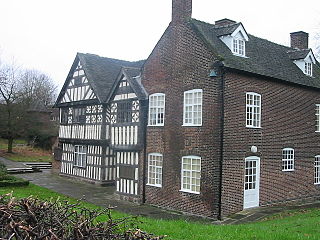
Ford Green Hall is a Grade II* listed farmhouse and historic house museum in Stoke-on-Trent, Staffordshire. The oldest parts of the house date from the late 16th century, with one wing being either added or greatly repaired at some point in the early 18th century. In its grounds, there also stands an 18th-century dovecote which shares the listed building status of the main farmhouse.

Moreton Corbet Castle is an English Heritage property located near the village of Moreton Corbet, Shropshire, England, 8 miles northeast of Shrewsbury. It is a Grade I listed building. The ruins are from two different eras: a medieval stronghold and an Elizabethan era manor house. The buildings have been out of use since the 18th century.

Lytes Cary is a manor house with associated chapel and gardens near Charlton Mackrell and Somerton in Somerset, England. The property, owned by the National Trust, has parts dating to the 14th century, with other sections dating to the 15th, 16th, 18th, and 20th centuries. "Yet all parts blend to perfection with one another and with the gentle sunny landscape that surrounds them," comments Nikolaus Pevsner. The House is listed as Grade I by English Heritage.

The Treasurer's House is a National Trust-owned property in Martock, in the English county of Somerset. It has been designated as a grade I listed building. Apart from the Bishop's Palace, Wells it is the oldest house in the county.

West Pennard Court Barn is a late 14th or early 15th century tithe barn which was built for Glastonbury Abbey. The Grade I listed building is between West Pennard and West Bradley in the English county of Somerset.
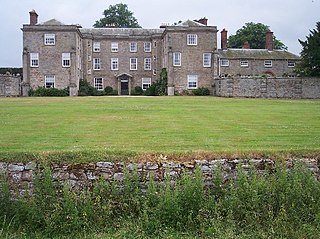
Morville Hall is a grade I listed country house and gardens in the care of the National Trust in the county of Shropshire, England, United Kingdom.

Wilderhope Manor is a 16th-century manor house in the care of the National Trust. It is located on Wenlock Edge 7 miles (11 km) south west of Much Wenlock in Shropshire, England. The manor is a Grade I listed building and since 1937 has been used as a youth hostel.
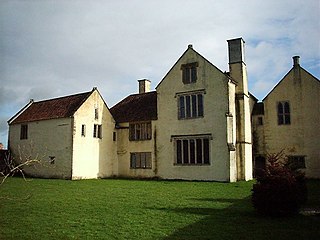
Gurney Manor in Cannington, Somerset, England is a 13th-century manor house with an attached chapel wing. It is now supported by the Landmark Trust and is available as holiday accommodation. It has been designated as a Grade I listed building and is considered notable partly due to the substantial survival of medieval construction throughout.

The Tribunal in Glastonbury, Somerset, England, was built in the 15th century as a merchant's house. It has been designated as a Grade I listed building.
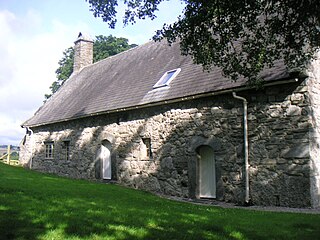
Plas Uchaf is a 15th-century cruck-and-aisle-truss hall house, 1.5 miles (2.4 km) south-west of Corwen, Denbighshire, Wales and 1 mile (1.6 km) north of Cynwyd. Its excellent workmanship indicates a house originally of considerable importance; it has been described as "of palatial significance".
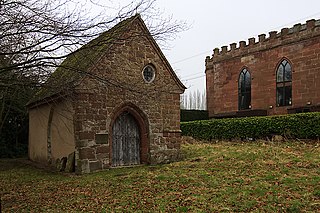
Talbot Chapel is the remaining part of a redundant Anglican church in the village of Longford, Shropshire, England. It has been designated by English Heritage as a Grade II* listed building, and is under the care of the Churches Conservation Trust. It stands beside St Mary's Church, which replaced the former medieval church.

Munslow is a small village and civil parish in Shropshire, England. It is situated on the B4368, 7 miles (11 km) northeast of the small town of Craven Arms, in the Corvedale, at around 140 metres (460 ft) above sea level.
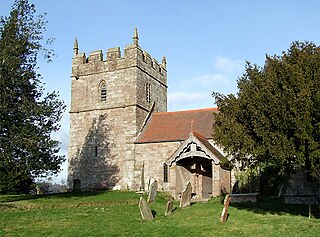
Holy Trinity Church is in the village of Holdgate, Shropshire, England. It is an active Anglican parish church in the deanery of Ludlow, the archdeaconry of Ludlow, and the diocese of Hereford. Its benefice is united with those of St Peter, Diddlebury, Broadstone Church, St Michael, Munslow, and St Catherine, Tugford. The church is recorded in the National Heritage List for England as a designated Grade I listed building. It stands in the former southwest bailey of Holdgate Castle.

Munslow is a hundred of Shropshire, England. It was formed with the amalgamation of the Anglo-Saxon hundreds of Patton and Culvestan during the reign of Henry I. Hundreds in England had various judicial, fiscal and other local government functions, their importance gradually declining from the end of manorialism to the latter part of the 19th century.
Culvestan was a hundred of Shropshire, England. Formed during Anglo-Saxon England, it encompassed manors in central southern Shropshire, and was amalgamated during the reign of Henry I with the neighbouring hundred of Patton to form the Munslow hundred.
Patton was a hundred of Shropshire, England. Formed during Anglo-Saxon England, it encompassed manors in eastern central Shropshire, and was amalgamated during the reign of Henry I with the neighbouring hundred of Culvestan to form the Munslow hundred.
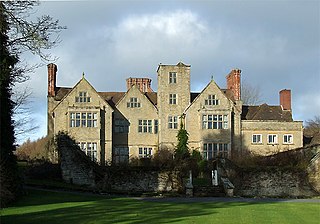
Shipton Hall is a large Elizabethan country house in the village of Shipton, Shropshire, England, which lies in the Corvedale valley some 7 miles south-west of Much Wenlock. It is a Grade I listed building.
Munslow is a civil parish in Shropshire, England. It contains 40 listed buildings that are recorded in the National Heritage List for England. Of these, one is listed at Grade I, the highest of the three grades, five are at Grade II*, the middle grade, and the others are at Grade II, the lowest grade. The parish contains villages and smaller settlements. including Aston Munslow, Beambridge, Broadstone, Hungerford, and Munslow, and the surrounding countryside. Most of the listed buildings are in the settlements, many of which are houses, cottages, farmhouses and farm buildings, the earliest of which are timber framed. The largest building is a country house, which is listed, together with associated structures and farm buildings, and there is also a mansion and a former manor house. The other listed buildings include a church with a 12th-century origin, an isolated chapel, a public house, a former mill house and mill buildings, a former smithy, and a war memorial.



















